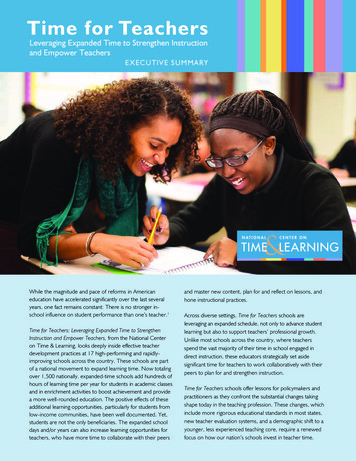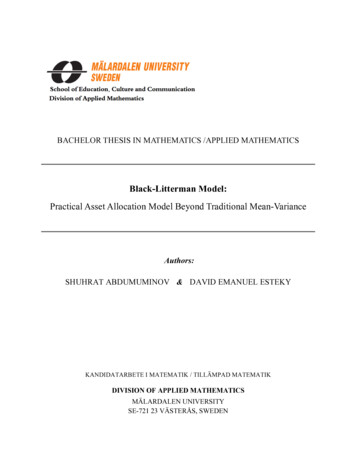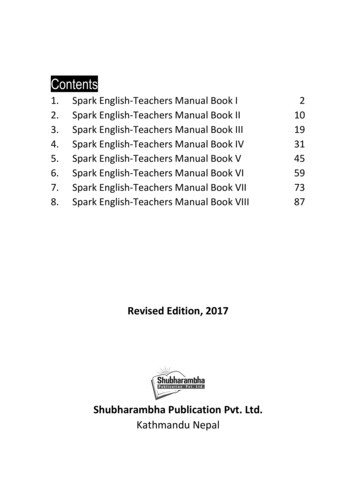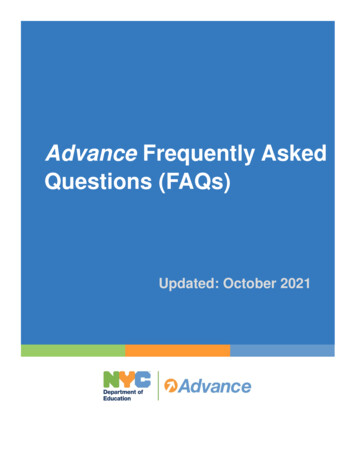
Transcription
Time for TeachersLeveraging Expanded Time to Strengthen Instructionand Empower TeachersEXECUTI VE S U M M AR YWhile the magnitude and pace of reforms in Americaneducation have accelerated significantly over the last severalyears, one fact remains constant: There is no stronger inschool influence on student performance than one’s teacher.1Time for Teachers: Leveraging Expanded Time to StrengthenInstruction and Empower Teachers, from the National Centeron Time & Learning, looks deeply inside effective teacherdevelopment practices at 17 high-performing and rapidlyimproving schools across the country. These schools are partof a national movement to expand learning time. Now totalingover 1,500 nationally, expanded-time schools add hundreds ofhours of learning time per year for students in academic classesand in enrichment activities to boost achievement and providea more well-rounded education. The positive effects of theseadditional learning opportunities, particularly for students fromlow-income communities, have been well documented. Yet,students are not the only beneficiaries. The expanded schooldays and/or years can also increase learning opportunities forteachers, who have more time to collaborate with their peersand master new content, plan for and reflect on lessons, andhone instructional practices.Across diverse settings, Time for Teachers schools areleveraging an expanded schedule, not only to advance studentlearning but also to support teachers’ professional growth.Unlike most schools across the country, where teachersspend the vast majority of their time in school engaged indirect instruction, these educators strategically set asidesignificant time for teachers to work collaboratively with theirpeers to plan for and strengthen instruction.Time for Teachers schools offer lessons for policymakers andpractitioners as they confront the substantial changes takingshape today in the teaching profession. These changes, whichinclude more rigorous educational standards in most states,new teacher evaluation systems, and a demographic shift to ayounger, less experienced teaching core, require a renewedfocus on how our nation’s schools invest in teacher time.
Rethinking Teacher TimeAccording to available data, the proportion of time Americanteachers have outside their classrooms to prepare forinstruction is much lower than it is in high-performingAsian and European nations. While many other countrieshave structures in place to enable consistent and frequentcollaboration and professional learning for teachers—likeregular “research lessons” in Japan and weekly curricularplanning sessions in Finland—schools in the United Statesare notable for the absence of such opportunities.2FIGURE 1.1Average Work Week for U.S. Teachers:Instructional vs. Non-instructional TimeFIGURE 1.2Average Work Week for Teachers in 17 Study Schools:Instructional vs. Non-instructional TimeWhile the average American teacher spends less than 20percent of her time at school outside the classroom—about7 total hours per week— teachers at schools featured in thisreport dedicate twice that proportion of time (40 percent)to activities that support their instruction.18.7%40.1%59.9%81.3%Instructional TimeNon-instructional TimeSource: Schools and Staffing Survey, 2011-12, Table 5 (Washington: U.S.Department of Education, National Center for Education Statistics). Note thatthe relevant question asks teachers to report on how many hours their contractstipulates time for instruction as distinct from all other time they are required tobe in school (including supervisory duties).2 TIME FOR TEACHERS – EXECUTIVE SUMMARYInstructional TimeNon-instructional TimeSource: Analysis of teacher schedules as reported by 17 Time for Teachersschools, 2013-14 school year.
About the ReportTime for Teachers explores the ways in which an expandedschedule creates opportunities for schools to invest in sixteacher development practices:(a) collaborative lesson planning(b) embedded professional developmentThree overarching themes emerge from these practices acrossthe Time for Teachers schools — themes that reinforce whatother effective-practices research on teacher development hasrevealed. These themes have important implications for howpractitioners and policymakers organize and optimize time forteacher development. Professional culture matters. Educators share a commitmentto continuous improvement. Teachers and administratorsembrace feedback, reflect openly on challenges, and valuethe input and ideas of their colleagues. School leaders workto create a climate that fosters professional growth.(c) summer training(d) data analysis(e) individualized coaching(f) peer observationThese practices are summarized briefly on pages 4 and 5,and in much greater depth in the full report, which includesexamples and vignettes from the 17 schools, and extensiveguidance for districts and schools looking to improve theirprofessional development programs. As educators interviewedfor the report attest, additional time is a lever that allowsthem to collaborate without sacrificing instructional time. Thatsaid, the practices described in the report are transferrableto schools with conventional schedules that are looking toimprove how they are using existing time in their school day. Teachers are leaders. Teachers serve as mentors andcoaches for their colleagues, lead team meetings, designcurricula, model instructional practices, and share theirexpertise. All teachers are deeply invested in strengtheninginstruction, not only in their classrooms but across thewhole school. The school is the locus of learning. Professionaldevelopment efforts are school-directed, strategicallydesigned to meet the needs of teachers and students,and driven by school-wide instructional goals. The varietyof activities are complementary, synergistic, and embeddedin practice.TABLE 1. Schools featured in Time for Teachers373% onal districtK-651093%1,320Cleveland, OHTraditional districtPK-8320100%1,425Frank M. Silvia Elementary SchoolFall River, MATraditional districtPK-581071%1,485KIPP Central City AcademyNew Orleans, LACharter5-843497%1,530Mastery Charter School - Shoemaker CampusPhiladelphia, PACharter6-1272182%1,307McGlone Elementary SchoolDenver, COTraditional districtK-568697%1,440Morton School of ExcellenceChicago, ILTraditional districtPK-840398%1,267Newton Elementary SchoolGreenfield, MATraditional districtK-321878%1,380Nicholas S. LaCorte-Peterstown School No. 3Elizabeth, NJTraditional districtK-865895%1,485The Preuss SchoolLa Jolla, CACharter6-1284693%1,352Roxbury Prep, Lucy Stone CampusBoston, MACharter5-724080%1,375The Soulsville Charter SchoolMemphis, TNCharter6-1253181%1,503UP Academy Charter SchoolBoston, MACharter6-846087%1,412Williamsburg Collegiate Charter SchoolBrooklyn, NYCharter5-831583%1,554YES College Prep - Southwest CampusHouston, TXCharter6-1280885%1,413School NameLocationSchool TypeGradesStudents*Achievement First Amistad High SchoolNew Haven, CTCharter9-12Biltmore Preparatory AcademyPhoenix, AZTraditional districtBrunson-Lee Elementary SchoolPhoenix, AZDouglas MacArthur Girls’ Leadership Academy*from most recent data available, as of March 2014TIME FOR TEACHERS – EXECUTIVE SUMMARY 3
About the PracticesCollaborativeLesson PlanningEmbedded ProfessionalDevelopmentSummerTrainingImproving Teachingthrough TeamworkBuilding Knowledgethrough CollaborationEstablishing Expectationsand Planning AheadNearly all of the 17 profiled schools areleveraging their expanded schedulesto provide structured opportunitiesfor teachers to plan lessons together.Teachers in these schools spend onaverage more than 90 minutes per weekworking in teams to plan lessons; in someschools they collaborate up to four hoursevery week. These educators report thatby investing time in collaborative lessonplanning, they are raising the quality andrigor of instruction because lessons aredesigned by a team of experts who eachbring varying and often complementaryskills and experience to the process.Through school-wide workshopsand team-based professional learningcommunities, teachers at the featuredschools are spending substantial timewith their colleagues reflecting oninstructional strategies and learning newways to strengthen their teaching. Unliketraditional professional development(often led by external experts and/or heldoutside the school), these embeddedlearning opportunities are highlyconnected to school-based instructionalgoals and engage teachers as experts inactive, peer-to-peer learning.Summer training helps schools lay thegroundwork for the deep collaboration thattakes place during the school year. Everysummer, for two to three weeks beforestudents arrive, 7 of the 17 profiled schoolsconvene their faculty for intensive planningand professional development. (Otherschools in this study offer their teachers upto one week of summer training.) At thesesummer sessions, teachers have significanttime to collaborate on instruction, build acommon understanding of their school’svision and mission, and learn about newtools and systems they will use throughoutthe course of the academic year.Keys to SuccessKeys to SuccessKeys to Success Clear, Meaningful Goalsand Deliverables Focused Use of Time A Foundation forOngoing Collaboration Structures to Support Planning Leadership Support and Guidance Content Driven by School Goals Peer-to-Peer Learning Differentiation of Content Aligned Expectations and Practices Tailored Support for New Teachers Results-focused Facilitation Teachers as Experts Professional Respect An Integrated Calendarof Development“The more that teachers plan and talkabout what it is we’re asking our kids todo, the better the teaching will be.”Faith Burtamekh, PrincipalBiltmore Preparatory AcademyPhoenix, AZ4 TIME FOR TEACHERS – EXECUTIVE SUMMARY“These sessions have built a realsense of trust and teamworkamong the teachers.”Ted Panagopoulos, District Instructional CoachElizabeth Public SchoolsElizabeth, NJ“Our summer prep is terribly important.We all get to practice, plan, and gearup for the year ahead.”Ashley Herring, Dean of StudentsRoxbury Prep, Lucy Stone CampusBoston, MA
xamining Student Performanceto Tailor InstructionHelping Teachers Succeed throughObservation and FeedbackSharing and HoningEffective PracticesData permeates teachers’ instruction,planning, and collaboration at each ofthe schools in this study. By spendingtime each week systematically collecting,analyzing, and planning around data,teachers at Time for Teachers schools arecontinuously identifying ways to bettermeet student needs. Through regulardata meetings and periodic “data days”—entire days when students do not haveclasses and teachers meet to analyze andrespond to data from recent benchmarkassessments — teachers identify studentlearning gaps and create action plans toaddress these gaps.At many profiled schools, individual teachersare paired with an instructional coach whosupports their ongoing development throughweekly observations and feedback. Thecoaching process is often cyclical—startingwith the submission of the upcoming week’slesson plans to the coach. The coach thenreviews and provides written feedback onthe lesson plans, and the teacher makesmodifications. At least once every week,the coach observes a class and then meetswith the teacher to discuss how the lessonsare going, provide instructional feedback,and identify concrete action steps with theteacher for the following week’s lesson.Recognizing the influential role peerobservation can play in improvinginstruction, leaders at many Timefor Teachers schools are creatingopportunities for teachers to observeone another in their classrooms. Theseeducators agree that non-evaluative peerobservations help enhance their skills andshare effective practices. Through peerobservation, teachers work to improve aspecific instructional practice or classroommanagement routine by watching anddebriefing with one another.Keys to SuccessKeys to SuccessKeys to Success Leadership Commitment to Data A Culture of ContinuousImprovement A Culture of Trust and Collaboration High-Quality Assessments Effective Supports for Analysis Meaningful Action Steps Training and Support for Coaches Focused, Individualized Goals Timely, “Bite-sized” Action Steps Collaborative Problem-solving“We can only see how well our students aredoing when we look closely at their workand their assessments.”RaStar West, Fourth-Grade TeacherMorton School of ExcellenceChicago, IL“I would never be where I am today if itweren’t for the feedback I have gottenregularly from my coach.”Claire Hollis, Pre-Calculus TeacherAchievement First Amistad High SchoolNew Haven, CT Connections to OtherProfessional Learning Focus on SpecificInstructional Practices Protocols that SupportReflection and Growth“When people observe me, I reallythink about my practice. It’s a learningopportunity for me, too.”Christine Carvalho, Fourth-Grade TeacherFrank M. Silvia Elementary SchoolFall River, MATIME FOR TEACHERS – EXECUTIVE SUMMARY 5
RecommendationsFrom both a policy and a practice perspective, one ofAmerica’s most vital education challenges is to ensure thateach and every classroom is led by an excellent educator.To realize this ambitious goal, we must acknowledge thata successful teaching force spends time not only teaching,but also collaborating, planning, leading, and learning. Thechallenge for policymakers and practitioners, therefore,is three-fold: to implement robust, effective professionaldevelopment systems; to empower teachers to continuallystrengthen their instruction; and to ensure that teachers’schedules and job expectations prioritize time for theirprofessional learning and development.Beyond describing the explicit ways that successful schoolsare investing in high-quality professional learning, Timefor Teachers also identifies a set of recommendations forpolicymakers and practitioners seeking to strengthen andbetter support teacher learning.For Policymakers1. Advance policies that enable schools to implement anexpanded school schedule that offers teachers additionaltime for professional learning. Teachers working in schoolswith conventional schedules often struggle to find the timethey need to work with colleagues, coaches, and administratorsto plan, reflect, and improve their practice. An expandedschool day and/or year provides more time overall for studentlearning and enables schools to expand time for teachers’professional development. The Time for Teachers schoolsare better able to carve out dedicated time for teachersto collaborate, such as when students are engaged inenrichment activities with other staff members orpartner organizations.2. Incentivize and fund high-quality, school-embeddedprofessional learning opportunities. In most school districtsacross the country, professional development incentives andfunding focus on courses, workshops, and sessions withexternal experts. Too often, this approach overlooks thetremendous value of job-embedded and teacher-ledprofessional learning opportunities, such as individualizedcoaching, peer observation, collaborative planning, andprofessional learning communities. Policymakers need toconsider how policies and resources can better support thefull range of learning taking place in the schools documentedin this report.3. Support job-embedded professional development as partof the training for the Common Core. National survey datashows that most efforts to train teachers on these morerigorous standards are limited to one- or two-day workshops.Meanwhile, teachers need ongoing, job-embedded learningopportunities like the practices featured in Time for Teachers6 TIME FOR TEACHERS – EXECUTIVE SUMMARYto effectively teach to these more complex standards.Policymakers at all levels need to consider how they canencourage and support collaborative professional learningto ensure effective Common Core implementation.4. Integrate and emphasize teacher feedback anddevelopment in new evaluation systems. Policymakersshould strive to ensure that new evaluation systems, whichare emerging across the country to comply with new stateregulations, provide teachers with opportunities for frequentand constructive feedback, along with clear action steps—notjust evaluation ratings. As district leaders continue to designthese systems, they must support the training of schooladministrators on how to leverage evaluations as a professionaldevelopment tool and a starting point for conversations aboutinstructional improvement.5. Incentivize and fund efforts at the school and district levelsto support and retain new teachers. Given the large numbersof new teachers entering the field, programs that supportthese beginning professionals must become a high priority forpolicymakers and practitioners alike. Policymakers can directresources to mentoring or induction programs—funding notjust the training itself, but also the time needed forveteran and new teachers to give and receive coaching.
For Practitioners1. Assess current professional development practices andteacher time use. Administrators and faculty can start byexamining how teachers at their school currently spend theirtime—including time for classes, individual preparation, andother duties. Based on this data, school leaders can work tofind additional time within the existing schedule for professionaldevelopment and identify opportunities to better use the timealready allocated for this purpose.2. Consider program models that enable additional time forteacher collaboration. We encourage school leaders torethink the existing school schedule and consider newapproaches to scheduling that might open up opportunitiesfor teacher collaboration and development. Program modelssuch as technology-based learning labs or enrichment activitiesled by partners or specialist teachers can free teachers toparticipate in professional learning during the school day.3. Align benchmark assessments, standards, and curricula,and share relevant, timely data with teachers. For teachersto be most effective, they must have a deep understanding ofeach of their student’s strengths and challenges. For thisreason, teachers need ready access to regular studentperformance data. Across Time for Teachers schools, timely,high-quality assessment data is a prerequisite for thoughtfulplanning and reflection.4. Support the development of a cadre of instructionalleaders and coaches in schools. Schools need to create ateam of instructional leaders and coaches. These individualscan take on a full array of responsibilities to support andstrengthen teacher development: facilitating team meetings,designing and delivering workshops on targeted topics,A successful teaching force spendstime not only teaching, but alsocollaborating, planning, leading,and learning.establishing processes for analyzing and responding tostudent data, conducting classroom observations, andproviding actionable instructional feedback.5. Expand opportunities for teachers to develop and shareexpertise. Empowering teachers with opportunities to leadand support their peers positively impacts both instructionand school culture. Districts and networks can encourageschool leaders to identify teachers who can take on newroles, such as leading workshops on instructional strategies,coaching their fellow teachers, and opening up theirclassrooms for observation. Districts and collective bargainingunits can also work together to develop a compensationsystem for teacher leaders.End NotesFor an effective summary of the research, see Eric A. Hanushek, StevenG. Rivkin, “Generalizations about Using Value-Added Measures of TeacherQuality,” American Economic Review, May 2010, 100:2, pp. 267-271.1Organisation for Economic Co-operation and Development, Educationat a Glance 2013: OECD Indicators (Paris: Author, 2011), Table D 4.1.The international average for countries reporting data is 67 percent. Alsosee Linda Darling-Hammond, et al, Professional Learning in the LearningProfession: A Status Report on Teacher Development in the United States andAbroad, (Dallas, TX: National Staff Development Council, 2009), pp. 15-18.2TIME FOR TEACHERS – EXECUTIVE SUMMARY 7
The National Center on Time & Learning (NCTL) is dedicated to expanding learning time to improve student achievement and enable a well-roundededucation. Through research, public policy, and technical assistance, NCTL supports national, state, and local initiatives that add significantly more schooltime to help children meet the demands of the 21st century and prepare for success in college and careers.AuthorsClaire Kaplan, Vice President, Knowledge Management & StrategyRoy Chan, Director of Effective PracticesDavid A. Farbman, Ph.D., Senior ResearcherAmi Novoryta, Deputy Director, Knowledge Management & StrategyEditorDiane Sherlock, Editorial DirectorResearch AssistantAmy Joy StahlDesignHelen Riegle, HER DesignAdditional PhotographyBobby NeptuneAcknowledgementsThis publication was made possible through the leadership support of The Joyce Foundation. NCTL also gratefully acknowledges Carnegie Corporationof New York, The Eli and Edythe Broad Foundation, the Ford Foundation, and the W.K. Kellogg Foundation for supporting NCTL’s knowledgemanagement work.The Joyce FoundationThe Joyce Foundation supports the development of policies that both improve the quality of life for people in the Great Lakes region and serve asmodels for the rest of the country. The Joyce Foundation’s grant making supports research into Great Lakes protection and restoration, energy efficiency,teacher quality and early reading, workforce development, gun violence prevention, diverse art for diverse audiences, and a strong, thriving democracy.The Foundation encourages innovative and collaborative approaches with a regional focus and the potential for a national reach.Learn more at joycefdn.orgTo download the full report of Time for Teachers: Leveraging Expanded Time to Strengthen Instruction and Empower Teachers, visit our website ndlearning.org24 School Street, 3rd FloorBoston, MA 02108617.378.3900Join us on Facebook@expanding time
Mastery Charter School - Shoemaker Campus Philadelphia, PA Charter 6-12 721 82% 1,307 McGlone Elementary School Denver, CO Traditional district K-5 686 97% 1,440 . UP Academy Charter School Boston, MA Charter 6-8 460 87% 1,412 Williamsburg Collegiate Charter School Brooklyn, NY Charter 5-8 315 83% 1,554











